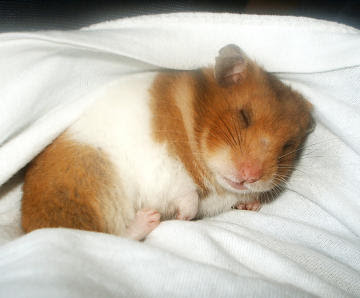A new study suggests that sex during adolescence can have lasting negative effects on the body and mood well into adulthood, most likely because the activity occurs when the nervous system is still developing.
While the research used laboratory animals, the findings provide information that may be applicable to understanding human sexual development.
Researchers paired adult female hamsters with male hamsters when the males were 40 days old, the equivalent of a human's mid-adolescence. They found that these male animals with an early-life sexual experience later showed more signs of depressive-like behaviors as well as lower body mass, smaller reproductive tissues and changes to cells in the brain than did hamsters that were first exposed to sex later in life or to no sex at all.
Among the cell changes observed in the animals that had sex during adolescence were higher levels of expression of a gene associated with inflammation in their brain tissue and less complex cellular structures in key signaling areas of the brain.
They also showed signs of a stronger immune response to a sensitivity test, suggesting their immune systems were in a heightened state of readiness even without the presence of infection – a potential sign of an autoimmune problem.
The combination of physiologic responses in adulthood don't necessarily cause harm, but do suggest that sexual activity during the nervous system's development might be interpreted by the body as a stressor, researchers say.
"Having a sexual experience during this time point, early in life, is not without consequence," said John Morris, a co-author of the study and a doctoral student in psychology at Ohio State University. "It could be affecting males' susceptibility to symptoms of depression, and could also expose males to some increase in inflammation in adulthood."
Morris presented the research Tuesday (11/15) at the Society for Neuroscience annual meeting in Washington, D.C. He conducted the study with Zachary Weil, research assistant professor, and Randy Nelson, professor and chair, both from Ohio State's Department of Neuroscience.
Previous research has most often examined the effects of adolescent sex on young women, and for ethical reasons must be done in humans as retrospective explorations of behavior. The Ohio State scientists used hamsters, which have physiologic similarities to humans, to learn specifically how the body responds to sexual activity early in life.
"There is a time in nervous system development when things are changing very rapidly, and part of those changes are preparations for adult reproductive behaviors and physiology," Weil said. "There is a possibility that environmental experiences and signals could have amplified effects if they occur before the nervous system has settled down into adulthood."
The scientists worked with five groups of male hamsters: two groups that had sex at age 40 days and were assessed at 40 days and 80 days after exposure to sex, two groups that had adult sex at age 80 days and were assessed at the same time intervals, and hamsters that had no sexual experience. Male hamsters reach puberty at age 21 days.
The researchers placed the adolescent and adult males in environments with in-heat female hamsters for six hours and recorded their encounters to ensure that sexual activity occurred.
The animals were subjected to a variety of tests when they all had reached adulthood. They were placed in mazes with options to explore open areas or hide in isolation; those that chose not to explore were showing signs of anxiety. Animals placed in water showed signs of depressive-like behavior if they stopped swimming vigorously.
"Both groups of sexually active hamsters showed an increase in anxiety-like behavior compared to the control group, but the increase in a depressive-like response was specific to the adolescent sexually paired group," Morris said.
A test of immune system sensitivity suggested that the hamsters with adolescent sexual experiences were at risk for excess inflammation as part of an enhanced immune response. In addition, these same hamsters had higher levels of a pro-inflammatory cytokine called interleukin-1, or IL-1, in their brain tissue than did the other hamsters. IL-1 is one of several chemical messengers that cause inflammation, most often to fight infection or repair injury; when it circulates without an infection to fight, the body experiences excess inflammation.
This elevated gene expression was seen in areas of the brain known not to reach maturity until well into adulthood – including the amygdala, prefrontal cortex, hippocampus and striatum. In some of these same areas of the brain, animals with adolescent sexual experience also showed less complexity in the dendrites, the branching segments from nerve cells that house the synapses, which carry signals to the brain from the rest of the body.
Without further research, the scientists don't know exactly what these brain differences mean. But because they are seen most prominently in the animals that were exposed to sex in adolescence, the scientists say, there is a clear association with that activity. "Sex is doing something physiological that these cells are interpreting and responding to with shorter dendrites," Weil said.
Finally, the hamsters that had adolescent sex had a smaller total body mass as well as a decrease in accessory reproductive tissue, including the seminal vesicles, vas deferens and epididymis, as adults.
"This suggests to us that maybe this process is causing the animals to have a maladaptive response reproductively, as well," Morris said.
Source: Ohio State University [November 15, 2011]





 Posted in:
Posted in: 








0 comments:
Post a Comment